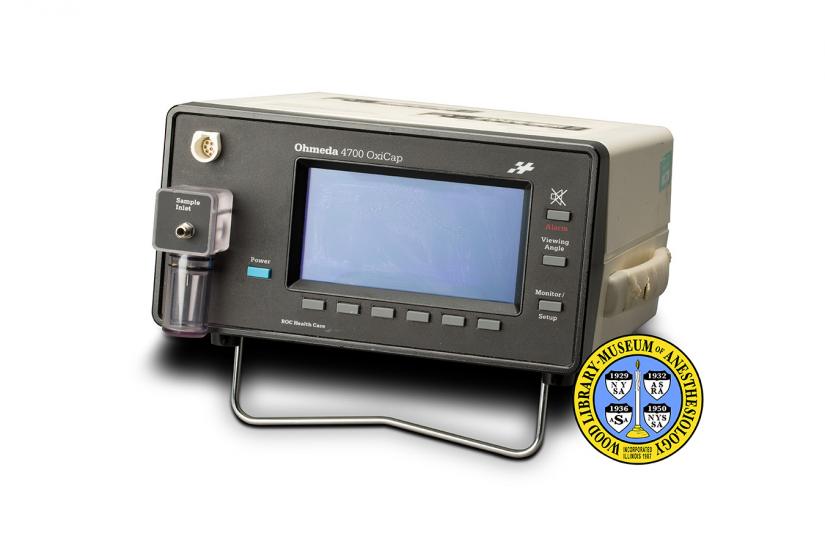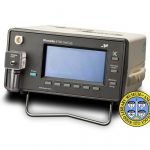Ohmeda 4700
Ohmeda 4700 OxiCap Monitor
Anesthesiologists monitor many signs of the patient’s physical status, both during and after surgery. As the patient inhales and exhales a mixture of gases, the amount of oxygen, carbon dioxide and anesthetic and other gases in his blood and breath change. The amount of carbon dioxide and anesthetic gases in the exhaled breath provides a good measure of the amount in the patient's blood. Measuring these gases during the anesthetic can indicate the patient’s changing needs, and alert the anesthesiologist to make adjustments. From the 1960s onward, electric and electronic monitors became increasingly common in operating and recovery rooms.
Spirometers, devices that measure the amount of air breathed in and out, were introduced in the late 18th Century. Since the mid-20th Century, a variety of instruments have been employed to obtain the more useful measurement of inspired oxygen concentration (abbreviated FiO2.) Capnographs, introduced in the 1950s, monitor the amount of carbon dioxide in the patient’s exhaled breath.
Modern pulse oximeters, introduced in the 1980s, measure the amount of oxygen in the patient’s blood. The Ohmeda 4700 OxiCap Monitor was introduced around 1988. It combined a pulse oximeter, a capnograph and an FiO2 monitor in one, portable unit. It displayed these measurements on the screen both in graphic forms and as numeric values.
Catalog Record: Ohmeda 4700
Access Key: alek
Accession No.: 2010-01-14-1 A
Title: Ohmeda 4700 OxiCap.
Corporate Author: Ohmeda.
Title variation: Alt Title
Title: 4700 OxiCap monitor.
Publisher: Louisville, CO : Ohmeda, [beteen 1987 and] 1988.
Physical Descript: 1 monitoring device : metals, plastics, rubber, glass ; 14.5 x 28 x 35 cm.
Subject: Monitoring, Intraoperative – instrumentation.
Subject: Capnography – instrumentation.
Subject: Oximetry – instrumenation.
Subject: Blood Gas Monitoring, Transcutaneous – instrumentation.
Note Type: General
Notes: The early year in the date range for the possible year of manufacture is
based on the year that Ohmeda applied for 510(k) Premarket Notification for
the 4700 OxiCap with the FDA (1987). It was approved in 1988. The end date is
based on the copyright date located at the end of the instructions that are
printed on the top of the device (©1988). The date range could change if
documentation, or expert opinion, indicates that it should be corrected.
Note Type: Citation
Notes: 510(k) Premarket Notification: K873199. https://www.accessdata.fda.
gov/scripts/cdrh/cfdocs/cfpmn/pmn.cfm?ID=K873199. Accessed January 18, 2015.
Note Type: Citation
Notes: Giordano CR, Gravenstein N. Capnography. In: Ehrenwerth J, Eisenkraft JB,
Berry JM, eds. Anesthesia Equipment: Principles and Applications. 2nd ed.
Philadelphia: Elsevier/Saunders; 2013:245-255.
Note Type: Citation
Notes: Jaffe MB. Brief history of time and volumetric capnography. In: Gravenstein
JS, Jaffe MB, Gravenstein N, Paulus DA, eds. Capnography. 2nd ed. Cambridge:
Cambridge University Press; 2011:415-429.
Note Type: Citation
Notes: The Ohmeda 4700 OxiCap Monitor [booklet]. [USA] : BOC Group Inc, 1988.
Note Type: Citation
Notes: Physician Anesthesiologists Week toolkit. American Society of
Anesthesiologists website. https://www.asahq.
org/advocacy/advocacy-tools/physician-anesthesiologists-week-toolkit.
Accessed January 19, 2015.
Note Type: Physical Description
Notes: One portable, rectangular respiratory monitor; The front and the back of the
device is black and the remainder of the device is cream colored; On the face
of the monitor is a digital screen; Above the screen are manufacturer
markings, “Ohmeda 4700 OxiCap”; To the right of the screen are three gray,
rectangular push buttons; The uppermost button has a symbol for muting the
alarm, and below it is the text, “Alarm” in red; The middle button is marked
“Viewing Angle,” and the lower button is marked “Monitor/Setup”; Below the
screen are six gray, rectangular push buttons that are not marked; Marked
below the button of the far left is, “BOC Health Care,”; To the left of the
screen is a blue rectangular push button marked, “Power”; Also to the left of
the screen is a port for the pulse oximeter probe, and the sample inlet port
and moisture separator; Printed on the top of the box are instructions for,
“Setup Mode,” and “Monitor Mode,” as well as a, “CAUTION”; A copyright
statement is located in the lower right of the instructions, “© 1988 The BOC
Group Inc [new line] All specifications subject to change without notice.
[new line] Printed in USA”; A handle to carry the monitor is on the right
side of the monitor; The handle has some tears in the material that covers
it; Above the handle on the far right is a sticker marked, “SWEDISH HOSPITAL
MEDICAL CENTER 3- 9424”; On the back of the device is a port for the sample
exhaust, on ON/OFF switch, port for the power cord, a serial interface, and
analog outputs for “SaO2,” “CO2,” “Aux 1,”, and “Aux 2”; Also, on the back of
the device are a number of manufacturer markings and warnings; The markings
include, “Ohmeda [new line] 4700 OxiCap Monitor,” “Serial Number FMNS00697,”
“U.S. Patents 4394572, 4407290, Other Pat. Pend.”, and “Ohmeda, Made in USA
[new line] Louisville CO 80027 [new line] A Division of The BOC Group Inc.
[new line] BOC Heath Care”; A bar attached to the bottom of the monitor can
be pivoted so that the monitor sits parallel to the table on which it sits;
Or the bar can be extended so that the monitor sits at an angle and the front
of the monitor is more visible if the monitor is sitting below eye-level.
Note Type: Reproduction
Notes: Photographed by Mr. Steve Donisch, in January or February of 2014.
Note Type: Acquisition
Notes: Donated to the WLM by Hannsjeorg Hasche-Klunder, MD.
Note Type: Exhibition
Notes: Selected for the WLM website.


